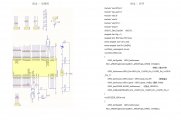基于GSM的智能家居系统设计

基于GSM的智能家居系统设计(任务书,开题报告,论文14500字)
摘 要
本文提出了一种自动化系统,用户可以使用语音命令来控制他们的电器,如光、风扇、电视、热水器等的主要目的是帮助人们更舒适的生活,尤其适合老年人和残疾人不必是实际存在附近的一个电器打开或关闭。该系统的重点是使用数字信号处理器来处理语音命令,并相应地控制所需的设备。XBee收发器用于消除处理器和设备之间的布线量大的neetl。实验结果表明,该系统响应良好,具有成本效益。我们的结论是,该系统为业主日常生活所面临的问题提供了解决方案,并提出了一个成本效益和可靠的解决方案,使他们的生活更舒适更舒适。
本设计是现代智能家居设计。采用了主从的控制理念,设计了2块控制电路板,一个是以51单片机为中心的家居信息(也包括报警信息)的采集。另一个是以STM32为中心的负责所有家居信息的显示人机对话与接受与处理以及同用户交换控制信息(通过GSM为通信载体)并发出控制命令的功能控制模块。
本设计的硬件模块包括主控制模块(采集报警信息),辅助控制系统模块(负责人机交互,信息传输),GSM通信模块,无线传输模块,供电模块以及其他外围电路。
关键词:口头命令,XBec,GSM通信,语音识别,无线传输, [资料来源:www.doc163.com]
AStudy on Smart Home Control System through Speech
Abstract
This paper proposes an automation system where users can use voice commands to control their electrical appliances, such as light, fan, television, heater etc. The main aim is to help make the life of people more comfortable, especially for the elderly and disabled as they will not have to be actually present near an appliance to turn it on or off. The system focuses on using a Digital Signal Processor to process the voice commands and accordingly control the required appliance. XBee transceivers are used to eliminate the neetl for large amount of wiring between the processor and the appliances. Experimental results show that the system has a good response and is cost effective. We conclude that this system provides solutions for the problems faced by home owners in daily life and make their life easier and more comfortable by proposing a cost effective and reliable solution.
A home automation system based on voice recognition was built and implemented. The system is targeted at elderly and disabled people to help ease their life. The system developed can be used to control AC and DC appliances through speech-Voice recognition was successfully implemented using the low power [资料来源:http://www.doc163.com]
Keywords:Spoken command,XBec,GSM communication,Speech Recognition,wireless transmission
[资料来源:Doc163.com]


目录
第一章 绪论 1
1.1 课题研究的背景 1
1.2 智能家居系统的技术现状 1
1.3 智能家居系统的发展趋势 2
1.4 系统的总体思路设计 3
1.5 本文的内容安排 4
第二章 系统方案和器件的选择 5
2.1 系统各部分器件设计 5
2.1.1微处理器器件选择 5
2.1.2传感器器件选择 6
2.1.3显示模块方案 6
2.1.4数据传递方案选择 7 [来源:http://Doc163.com]
2.2 最终方案的选择 11
第三章 硬件电路设计 12
3.1 单片机相关电路 12
3.2 数据采集部分 15
3.3 液晶屏显示电路 16
3.4 数据传输部分 17
第四章 程序设计 19
4.1 程序的编译方式选择 19
4.2软件部分的大致描述 19
4.3数据采集程序设计 21
4.4显示程序设计 24
4.5蓝牙模块程序设计 26
第五章 系统调试,分析与结果 30
第六章 系统总结与展望 34
参考文献 35
附录一 原理图 37
附录二 程序 38 [资料来源:http://doc163.com]
